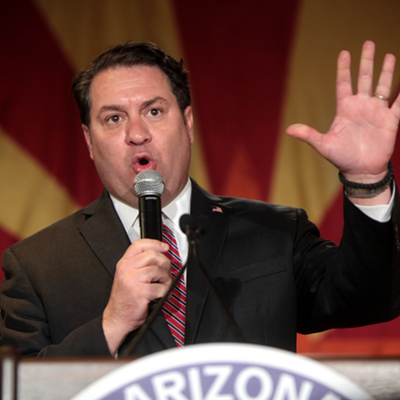At a candidates' forum last week at the Temple of Music and Art, artsy citizens hoping to hear about specific policies learned that Mayor Bob Walkup, the Republican trying for re-election, loves the arts so much he recently sang "The Star-Spangled Banner" at a baseball game. And Kimberly Swanson, the Libertarian candidate, revealed that she's made her living as an artist for 26 years, doing everything from acting to directing the upcoming Halloween play at the Valley of the Moon.
Democratic contender Tom Volgy was at least able to point to things he had done in his four-year tenure as mayor, from 1987-1991. Volgy said that under his watch, the Temple of Music and Art was restored and returned to active use as a theater, the downtown Arts District was created, the 1 percent for public art rule was instituted in capital projects, a $1 hotel surcharge tax was levied as a dedicated funding source for the arts, and the late, lamented Downtown Saturday Night, more popularly known as Saturday Night Live, flowered on downtown's now-mean streets.
Walkup countered that he's given Back to Basics money to downtown, and saw to it that a line supporting culture was included in a city vision statement for the first time.
The candidates, seated onstage in front of the set for Arizona Theater Company's production Over the Moon, also included City Council candidates: Ward 1 Democratic incumbent José Ibarra and Republican challenger Armando Rios Jr. ; Ward 4 Democratic incumbent Shirley Scott and Republican contender Mike Jenkins; and Ward 2's Carol West, a Democrat running unopposed. All the candidates agreed that the arts should serve as an economic engine to rev up the city's sputtering economy, but nobody seemed entirely sure how the $1 hotel arts surcharge ended up in the city's general fund.
"It ought to be given back," Volgy declared, and nobody dissented.
More contentious was the issue of how to distribute arts education fairly to kids in every neighborhood in the city. Get the Tucson Pima Arts Council to do it, Rios said, by sending the groups that get TPAC grants to into the schools. Ibarra said the city needs to forge stronger links with the financially strapped Tucson Unified School District, but he also supports neighborhood projects that have had barrio kids interviewing their elders and publishing their oral histories in books.
Walkup told a heartwarming story about how he once gave a drawing lesson to a gangbanger he met in the Tucson Children's Museum (where his wife, Beth, used to be executive director), and the how boy subsequently went on to study graphic arts in college. Art, he said, "saves lives." Volgy noted that arts education "often becomes the province of rich kids' families," and said the city should work through TPAC and the Metropolitan Education Commission to make sure more students get exposed to the arts.
The evening's best moment--or best piece of performance art--came when Swanson pulled out a piece of wood-and-cloth sculpture she had made. She said it took her six years to craft the wooden staff and make the thousands of tiny knots in the pieces of cloth dangling from it. She used the earth's own pigments to stain its green and brown strands, she said, and then, waving the staff over Volgy's head, she revealed that she had used her own menstrual blood to color the reds.
When the gasps died down, Volgy looked up and declared, "Amen."
JAMMED GLOCK: In a foolish and unprecedented move six years ago, the Pima County Board of Supervisors caved into pressure from then-Mayor George Miller and the City Council, and included a whole batch of city projects in the bond smorgasbord that cost taxpayers more than $700 million, including $350 million for roads.
The city promised to pay more than half for the projects. But when the city started making plans two years ago to use the millions of dollars it was supposed to devote to widening 22nd Street on Grant Road or Broadway, recently retired Democratic Supervisor Dan Eckstrom smelled blood and, with stunning efficiency, moved $10 million in county money for 22nd Street to other southside neighborhoods.
City officials foul cried--even though it was clear that it was the city that reneged.
To wit: A July 1997 letter then-City Manager Luis Gutierrez wrote to Pima Prime Minister Chuck Huckelberry that notably declares: "The mayor and council requested the county fund approximately $184.1 million of the total projects costs with its bond election, with the city committing to construct the remaining $204.75 million of system improvements through other funding sources."
Which brings us to an Oct. 1 love letter from Jim Glock, the city transportation director, to his Pima counterpart, the invisible Kurt Weinrich, in which Glock asserts City Hall's revisionist party line.
"Simply put," Glock simply wrote, "the city does not share your repeated assertion that mayor and council committed their financial participation. That Pima County construes mayor and council's actions differently is unfortunate and detrimental to our joint desire to improve the region's overall transportation system."
Glock goes on to directly contradict the correspondence that passed back and forth in 1997.
"Yes, a series of projects were listed in the correspondence sent from Luis Gutierrez to Chuck Huckelberry on July 1, 1997 that indicated the City of Tucson would be responsible for some of them," Glock told Weinrich. "However, nowhere in that correspondence did the city indicate it would share in funding the projects that it sought Pima County to include in the bond program."
Too bad, for Glock and his bosses, that Gutierrez's letter in 1997 states repeatedly where the city's $204.75 million will go.
ANN-LEAVE PEDERSEN: Less than 10 months into her gig running the Tucson Citizen news operations, Ann-Eve Pedersen is begging for a break. Who could blame her? She'll take three months, we're told, and then decide if she wants to return, and in what capacity. She may just direct special projects.
The politically wired Pedersen began as a Citizen clerk, moved up to become a talented reporter, and was drafted by the Arizona Daily Star 10 years ago. She then displaced John Silva as Star city editor, but only lasted about two years before fleeing for domesticity.
She and Democratic activist/lawyer Peter Eckerstrom--now on the Arizona Court of Appeals--have a young son. The grind of propping up Citizen editor Michael Chihak, as well as putting her stamp on every story, was just too great a task.
Her duties will fall to Joseph Garcia, who must be amused that he no longer has to play substitute teacher in the daily news meetings, and Jennifer Boice, the former biz section gal who helped redesign the Citizen Web page.
Chihak is losing his other crutch. Cathy Davis is resigning from her job as the CEO of Tucson Newspapers Inc., the company the Star and Citizen created to handle advertising, printing and business operations for the "competing" papers.







